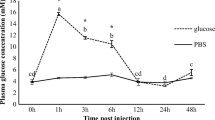Summary
The purpose of these experiments was to determine which exogenous energy sources are suitable for isolated follicle cell-free oocytes from the frog,Xenopus laevis. In order to compare prospective energy sources, follicle cell-free oocytes from 0.4 to 1.3 mm in diameter were incubated in a 1 mM concentration of each of a variety of energy sources and scored daily for the maintenance of morphological characteristics. Vitellogenic oocytes placed in succinate or fumarate deteriorated at the same time as those in saline alone. Oocytes incubated in oxaloacetate (OAA) appeared to remain in the best morphological condition, followed by oocytes maintained in pyruvate or glucose. Fully grown oocytes were tested at various times of incubation for their ability to respond to progesterone by undergoing germinal vesicle breakdown. These experiments showed that oocytes placed in OAA or pyruvate retained the ability to respond to progesterone longer than those in the other energy sources. Increased respiratory rates were stimulated in isolated oocyte mitochondria by succinate as well as pyruvate and OAA. However, oocytes incubated in labelled pyruvate evolved 80 to 140 times as much labelled CO2 as oocytes incubated in labelled glucose or succinate. In addition, it was found that the rate of uptake of pyruvate is 20 to 25 times greater than the rate of uptake of glucose or succinate. It is concluded from these experiments that OAA and pyruvate are the most effective exogenous energy sources for the in vitro maintenance ofXenopus oocytes. One possible explanation for the ineffectiveness of glucose or succinate as exogenous energy sources is a restriction in their uptake into the oocytes.
Similar content being viewed by others
References
Biggers, J. D. 1972. Metabolism of the oocyte. In: J. D. Biggers and A. W. Schuetz (Eds.),Oogenesis. University Park Press, Baltimore, pp. 241–251.
Brinster, R. L. 1965. Studies on the development of mouse embryosin vitro. II. The effect of energy source. J. Exp. Zool. 158: 59–68.
Brinster, R. L. 1967. Carbon dioxide production from lactate and pyruvate by the preimplantation mouse embryo. Exp. Cell Res. 47: 634–637.
Brinster, R. L. 1969. Radioactive carbon dioxide production from pyruvate and lactate by the preimplantation rabbit embryo. Exp. Cell Res. 54: 205–209.
Rushmer, R. A. and R. L. Brinster. 1973. Carbon dioxide production from pyruvate and glucose by bovine oocytes. Exp. Cell Res. 82: 252–254.
Gwatkin, R. B. L. 1972. Chemically defined media for mammalian eggs and early embryos. In Vitro 8: 59–67.
Wallace, R. A., D. W. Jared, J. N. Dumont, and M. W. Sega. 1973. Protein incorporation by isolated amphibian oocytes. III. Optimum incubation conditions. J. Exp. Zool. 184: 321–334.
Dumont, J. N. 1972. Oogenesis inXenopus laevis (Daudin). I. Stages of oocyte development in laboratory maintained animals. J. Morph. 136: 153–164.
Lowry, O., N. Rosebrough, A. Farr and R. Randall. 1951. Protein measurement with the Folin phenol reagent. J. Biol. Chem. 193: 265–275.
Wallace, R. A., T. Ho, D. W. Salter and D. W. Jared. 1973. Protein incorporation by isolated amphibian oocytes. IV. The role of follicle cells and calcium during protein uptake. Exp. Cell Res. 82: 287–295.
Brachet, J., E. Baltus, A. DeSchutter, F. Hanocq, J. Hanocq-Quertier, E. Hubert, S. Iacolbelli and G. Steinert. 1974. Biochemical changes during progesterone-induced maturation inXenopus laevis oocytes. Mol. Cell. Biochem. 3: 189–205.
Brachet, J. 1967. Effects of actinomycin, puromycin and cycloheximide upon the maturation of amphibian ovocytes. Exp. Cell Res. 48: 233–236.
Merriam, R. W. 1972. On the mechanism of action in gonadotropic stimulation of oocyte maturation inXenopus laevis. J. Exp. Zool. 180: 421–426.
Schuetz, A. W. 1967. Action of hormones on germinal vesicle breakdown in frog (Rana pipiens) oocytes. J. Exp. Zool. 166: 347–354.
Smith, L. D. and R. E. Ecker. 1969. Role of the oocyte nucleus in physiological maturation inRana pipiens. Devel. Biol. 19: 281–309.
Barbehenn, E. K., R. G. Wales, and O. H. Lowry. 1974. The explanation for the blockage of glycolysis in early mouse embryos. Proc. Nat. Acad. Sci. U.S.A. 71: 1056–1060.
Legname, A. H., H. Salomon de Legname, S. S. Sanchez, A. N. Sanchez Riera and S. N. Fernandes. 1972. Metabolic changes inBufo arenarum oocytes induced by oviductal secretions. Devel. Biol. 29: 283–292.
Author information
Authors and Affiliations
Additional information
Research supported by grants 10179 from the Research Foundation of the City University of New York and BMS 74-18790 from the National Science Foundation.
Rights and permissions
About this article
Cite this article
Eppig, J.J., Steckman, M.L. Comparison of exogenous energy sources for in vitro maintenance of follicle cell-freeXenopus laevis oocytes. In Vitro 12, 173–179 (1976). https://doi.org/10.1007/BF02796439
Issue Date:
DOI: https://doi.org/10.1007/BF02796439




